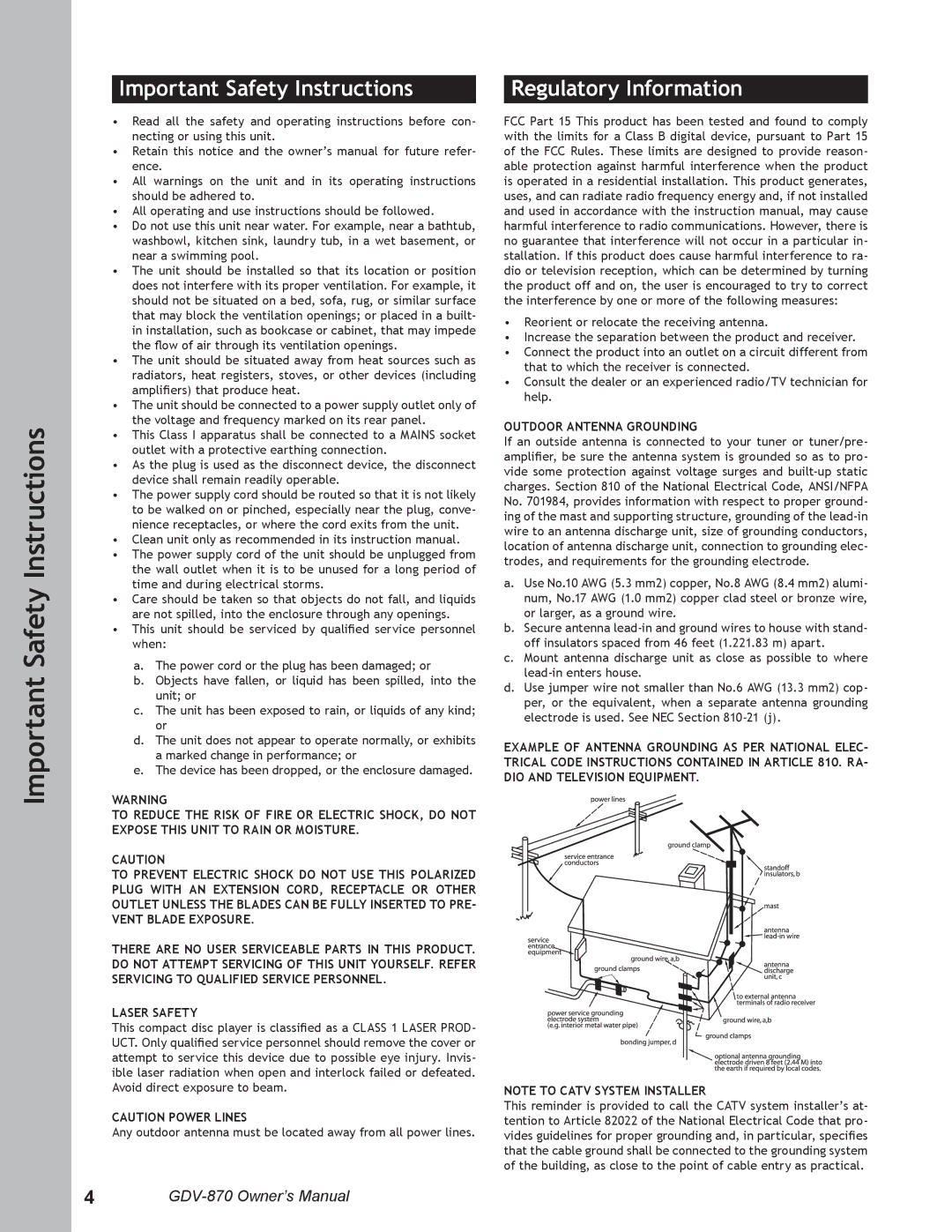
Important Safety Instructions
Important Safety Instructions
•Read all the safety and operating instructions before con- necting or using this unit.
•Retain this notice and the owner’s manual for future refer- ence.
•All warnings on the unit and in its operating instructions should be adhered to.
•All operating and use instructions should be followed.
•Do not use this unit near water. For example, near a bathtub, washbowl, kitchen sink, laundry tub, in a wet basement, or near a swimming pool.
•The unit should be installed so that its location or position does not interfere with its proper ventilation. For example, it should not be situated on a bed, sofa, rug, or similar surface that may block the ventilation openings; or placed in a built- in installation, such as bookcase or cabinet, that may impede the flow of air through its ventilation openings.
•The unit should be situated away from heat sources such as radiators, heat registers, stoves, or other devices (including amplifiers) that produce heat.
•The unit should be connected to a power supply outlet only of the voltage and frequency marked on its rear panel.
•This Class I apparatus shall be connected to a MAINS socket outlet with a protective earthing connection.
•As the plug is used as the disconnect device, the disconnect device shall remain readily operable.
•The power supply cord should be routed so that it is not likely to be walked on or pinched, especially near the plug, conve- nience receptacles, or where the cord exits from the unit.
•Clean unit only as recommended in its instruction manual.
•The power supply cord of the unit should be unplugged from the wall outlet when it is to be unused for a long period of time and during electrical storms.
•Care should be taken so that objects do not fall, and liquids are not spilled, into the enclosure through any openings.
•This unit should be serviced by qualified service personnel when:
a.The power cord or the plug has been damaged; or
b.Objects have fallen, or liquid has been spilled, into the unit; or
c.The unit has been exposed to rain, or liquids of any kind; or
d.The unit does not appear to operate normally, or exhibits a marked change in performance; or
e.The device has been dropped, or the enclosure damaged.
WARNING
TO REDUCE THE RISK OF FIRE OR ELECTRIC SHOCK, DO NOT EXPOSE THIS UNIT TO RAIN OR MOISTURE.
CAUTION
TO PREVENT ELECTRIC SHOCK DO NOT USE THIS POLARIZED PLUG WITH AN EXTENSION CORD, RECEPTACLE OR OTHER OUTLET UNLESS THE BLADES CAN BE FULLY INSERTED TO PRE- VENT BLADE EXPOSURE.
THERE ARE NO USER SERVICEABLE PARTS IN THIS PRODUCT. DO NOT ATTEMPT SERVICING OF THIS UNIT YOURSELF. REFER SERVICING TO QUALIFIED SERVICE PERSONNEL.
LASER SAFETY
This compact disc player is classified as a CLASS 1 LASER PROD- UCT. Only qualified service personnel should remove the cover or attempt to service this device due to possible eye injury. Invis- ible laser radiation when open and interlock failed or defeated. Avoid direct exposure to beam.
CAUTION POWER LINES
Any outdoor antenna must be located away from all power lines.
Regulatory Information
FCC Part 15 This product has been tested and found to comply with the limits for a Class B digital device, pursuant to Part 15 of the FCC Rules. These limits are designed to provide reason- able protection against harmful interference when the product is operated in a residential installation. This product generates, uses, and can radiate radio frequency energy and, if not installed and used in accordance with the instruction manual, may cause harmful interference to radio communications. However, there is no guarantee that interference will not occur in a particular in- stallation. If this product does cause harmful interference to ra- dio or television reception, which can be determined by turning the product off and on, the user is encouraged to try to correct the interference by one or more of the following measures:
•Reorient or relocate the receiving antenna.
•Increase the separation between the product and receiver.
•Connect the product into an outlet on a circuit different from that to which the receiver is connected.
•Consult the dealer or an experienced radio/TV technician for help.
OUTDOOR ANTENNA GROUNDING
If an outside antenna is connected to your tuner or tuner/pre- amplifier, be sure the antenna system is grounded so as to pro- vide some protection against voltage surges and
a.Use No.10 AWG (5.3 mm2) copper, No.8 AWG (8.4 mm2) alumi- num, No.17 AWG (1.0 mm2) copper clad steel or bronze wire, or larger, as a ground wire.
b.Secure antenna
c.Mount antenna discharge unit as close as possible to where
d.Use jumper wire not smaller than No.6 AWG (13.3 mm2) cop- per, or the equivalent, when a separate antenna grounding electrode is used. See NEC Section
EXAMPLE OF ANTENNA GROUNDING AS PER NATIONAL ELEC- TRICAL CODE INSTRUCTIONS CONTAINED IN ARTICLE 810. RA- DIO AND TELEVISION EQUIPMENT.
NOTE TO CATV SYSTEM INSTALLER
This reminder is provided to call the CATV system installer’s at- tention to Article 82022 of the National Electrical Code that pro- vides guidelines for proper grounding and, in particular, specifies that the cable ground shall be connected to the grounding system of the building, as close to the point of cable entry as practical.
4
